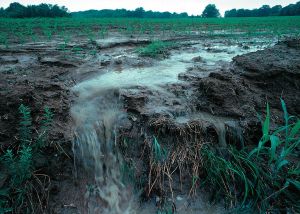
There are many types of pollution that affect the St Lucie River/Indian River Lagoon but two words you will hear over and over are “point” and “non-point pollution.” These are important words to understand especially today as we fight to save our rivers.
Point pollution is basically pollution that you can pin-point coming out of a “pipe.” Point pollution is associated with industry. For instance, a waster water treatment plant that has a pipe releasing into the river is point pollution. In the late 1800s and early 1900s some residences, businesses and industries just let their pollution and or sewage go directly into the St Lucie River and Indian River Lagoon. Yuk!
This practice improved with the advent of sewer systems, septic and organized cities but there were/are still direct pipes releasing very unclean water until very recently. Recognizing the impacts of discharges from wastewater treatment plants, the Florida Legislature passed the Indian River Act (Chapter 90-262) in 1990 requiring waste water treatment plants to cease discharging their effluent, somewhat processed poop, into the lagoon. Because it was easy to pinpoint exactly where these industrial wastewater points are/were located, it is fairly easy to regulate them.
The lagoon and we have befitted from the Indian River Act 90-262 but we still have problems.
Non-point pollution, unlike point source pollution, is pollution that is hard to pin-point because it is coming from “everywhere.” On average it rains 50 inches each year along the Treasure Coast. Highways, parking lots, people’s yards, leaky septic tanks, and agriculture all combine to create a cocktail of oils, heavy metals, fertilizer, pesticides, herbicides, viruses, bacteria and other pollutants that run from flowing rain water into area canals and then straight into the St Lucie River/Indian River Lagoon.
To complicate things more, cities and counties can regulate residential applications (for instance many have recently passed strict fertilizer ordinance outlawing the use of nitrogen and phosphorus fertilizer application during rainy season,) but cities are not allowed to regulate agriculture even if is located in their city or county.
Agriculture is exempt from such laws. Agriculture is regulated and overseen by the Florida Department of Agriculture.
The Department of Agriculture recognizing the need to abate fertilizer and chemical runoff does promote “best management practices,” helping farmers work to lower phosphorus and nitrogen runoff but this is voluntary and not required. Most farmers do comply but it is not easy to judge and measure so agriculture runoff continues to significantly add to river pollution across our nation and state as we know from our C-44 canal that dumps mostly agriculture basin runoff into our rivers.
You will often hear people say, “We must stop pollution at the source!” This is a good idea and our state and federal agencies are doing it with point source pollution but not with non-point source pollution.
Perhaps one day every yard and every agriculture field will have to take a portion of their land to hold rain runoff so the pollutants seep into the earth before they go to our waterways? Perhaps one day the Department of Environmental Protection and the US Environmental Protection Agencies will become more hard-core rather than coming up with programs like TMDLs and BMP–Total Maximum Daily Loads for phosphorus and nitrogen and Basin Management Action Plans, because although those will help over time, like 30 years, we don’t seem to have a lot of time left.
___________________________________________________
Point Source Pollution (http://en.wikipedia.org/wiki/Point_source_pollution)
Non Point Pollution (http://en.wikipedia.org/wiki/Nonpoint_source_pollution)
Best Management Practices (http://solutionsforyourlife.ufl.edu/hot_topics/agriculture/bmps.html)
TMDL/BMAPS FDEP (http://www.dep.state.fl.us/water/tmdl/)
IRL Study Guide, pg. 11 Point/Non Point Pollution: (http://t.co/LqUx4eqxS1)
Go girl;)
Sent from my iPhone
>
Miss you Nic.
Spot on explanation Jacqui. It all goes back to Comgress and the Senate, bodies of government that ensures that big Ag cannot be regulated by cities, counties, etc. Until that changes, we are spinning our wheels. Agree?
I do not think we are spinning our wheels. The public is becoming more aware and disgusted . This will and is changing things even the hearts of reflective sun glasses wearing politicians —- very, very slowly. 🙂
Residents can do this now with a rain barrel at each corner of their home. 220 gallons pulled by each home per rain incident in Orlando would make significant impact. WTG Jacqui.
Rain barrels are helpful. I had one but I had so many mosquitoes in it the town of SEWALLS point requested I empty it! I even tried Clorox and they still bred. Do you have any advice captain?
Jacqui, where I come from we used mosquito dunks, added an EXTRA screen, or thin netting, depending on the design of the barrel, or put vegetable oil on the surface of the water every week or so… some people swear by goldfish, but I don’t know if I like that idea…